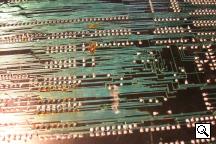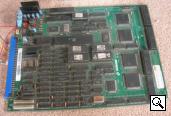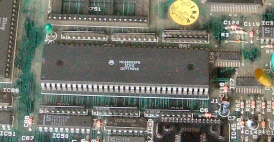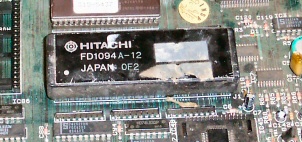|
|
|||||||
|
|
Whats New?
TechnicalBiopod ReaderJamma projects FunArcade ControlsPinball OtherWebcamFile downloads Contact Updates by RSS by RSS
 by Email by Email
|
JAMMA projects
The guts of arcade video games... The term JAMMA refers to the universal connector which connects the PCB to the
wiring harness of an arcade cabinet. It was agreed amongst most game manuafaturers that adopting the specification
of the JAMMA connector would allow Site Ops to change their games without having to change the cabinet. Contents
Moonwalker Board RepairUPDATED - 11th March 2007 The first of the bunch had obviously been kicked around a warehouse floor for a few years, there seems to be a reasonable amount of physical damage to the board probably because the previous owner had deemed it unrepairable.
The board outputs no sound or video upon power-up, and the main CPU appears to do nothing. I certainly wasn't expecting
any sound from it since the sound CPU had been pulled.
Sunset RidersMade by Konami in 1991, this is a much simpler single layered board. Like Moonwalker, it uses a 68000 CPU and a Z80 for the sound. There wasn't a great deal wrong with this one, the audio was reported broken which turned out to be poor contact volume pots. They'd obviously never been adjusted.
Mortal Kombat 2UPDATED - 11th March 2007
Mortal Kombat is considered to be one of the best beat-em-ups of all time, particularly in the Mortal Kombat series
the second one is usually rated even over MK4.
When powered up, the screen did indeed complain that most of the ROMs had failed their checksums - peculiarly
all on the upper board... not so peculiar once I'd noticed it'd been plugged in with half the pins hanging over
the edge of the socket! After I reseated the plug, without the obvious pin offset, the game booted successfully.
There are twelve 8Mbit graphics ROMs, two 4Mbit game ROMs and six 4Mbit sound ROMs totalling 128Mbits - thats 16MB of
data stored in solid state ROMs. Not something that sounds impressive these days, but you really need to put it into context.
This is basic, low-level shit; the CPU runs at a steady 10MHz. JAMMA on a TV
Since all JAMMA boards output RGB video signals, they can be easily connected to a standard TV via the SCART input. Suicide batteries
Some manufacturers, including Sega, designed a custom package which surrounded the CPU. The epoxy sealed package contains a small amount of SRAM which holds a key needed to decode the encrypted ROMs.
Comments... strobey, 30/01/09 @ 11:00 GMT:
I think this diagram will help you:http://personal.telefonica.terra.es/web/mad2/JAMMA2SCART.png Joe Elias, 08/03/13 @ 22:24 GMT:
Hi, I found your page, read the text about suicide battery. I have a M.J. MOONWALKER game that was working all right and now don't boot video or sound, is there a way to fix it?, Congratulations for you page!
strobey, 13/03/13 @ 15:07 GMT:
It is extremely possible that this is a suicide battery, this game is getting on for 30 years old now, so those batteries must be on their last legs!There are some unencrypted (bootleg) MJ ROMS that work with a plain old 68000 CPU, so I would replace the CPU/battery block and encrypted ROMS for a kick off. Boardset 317-0158, replace 2 ROMS: 13232 and 13233 Boardset 317-0159, replace 2 ROMS: 13234 and 13235 You'll have to do some googling to find the ROMs. |
|||||
|
|
(c) tp 2005-06 | XHTML 1.0 compliant
|
||||||











i think my rgb is right maybe its grounds or sync ??
(Everything video was nearly black) Sound OK.
Much please about exact terms wiring JAMMA it SCART. diagram.
thank you